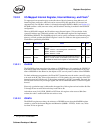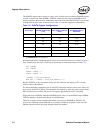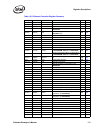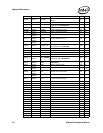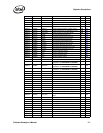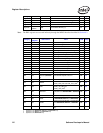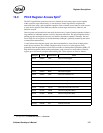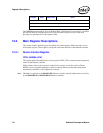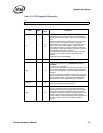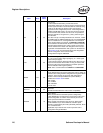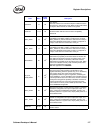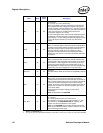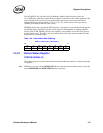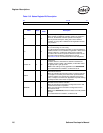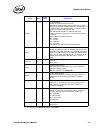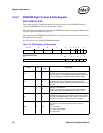
Software Developer’s Manual 225
Register Descriptions
Table 13-3. CTRL Register Bit Description
31 0
Device Control Bits
Field Bit(s)
Initial
Value
Description
FD 0
1b
0b
1
Full-Duplex
Enables software to override the hardware Auto-Negotiation
function. The FD sets the duplex mode only if CTRL.FRCDPLX
is set.
When cleared, the Ethernet controller operates in half-duplex;
when set, the Ethernet controller operates in full-duplex.
When the Ethernet controller operates in TBI mode/internal
SerDes mode, and the AN Hardware is enabled, this bit is
ignored. When the Ethernet controller operates in TBI mode/
internal SerDes, and the AN Hardware is disabled, or the link is
forced, this bit should be set by software.
When the Ethernet controller operates in internal PHY mode,
the FD bit is set by software based on AN and data rate
resolution.
Configurable through the EEPROM.
Reserved 2:1 0b These bits are reserved and should be set to 00b.
LRST 3 1b
Link Reset (not applicable to the 82540EP/EM, 82541xx, or
82547GI/EI)
0b = Normal; 1b = Link Reset
Applicable only in TBI mode/internal SerDes of operation. Used
to reset the link control logic and restart the Auto-Negotiation
process, when TXCW.ANE is set and TBI mode/internal SerDes
is enabled.
When set, transmission and reception are halted regardless of
TBI mode/internal SerDes setting. A transition to 0b initiates the
Auto-Negotiation function. Configurable from the EEPROM,
allowing initiation of Auto-Negotiation function at power up.
Reserved 4 0b
Reserved
Factory use only. Should be written with 0b.
ASDE 5 0b
Auto-Speed Detection Enable.
When set, the Ethernet controller automatically detects the
resolved speed of the link by sampling the link in internal PHY
mode and self-configures the appropriate status and control
bits. Software must also set the SLU bit for this operation. This
function is ignored in TBI mode/internal Serdes. The ASD
feature provides a method of determining the link speed without
the need for software accesses to the MII management
registers.



